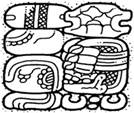
![]()

![]()

![]()
K&H.p80.#9 JM.p55.#3 BMM9.p15.r4.c3 BMM9.p15.r4.c4 JM.p55.#4 JM.p56.#2
CHAM CHAM CHAM CHAM CHAM CHAM:mi




K&L.p35.#4 TOK.p22.r1.c1 TOK.p22.r1.c2 DO - Unprovenanced Wall Panel (Houston) F1
CHAM CHAM / 10 CHAM <CHAK:TOOK’:<TUUN:ni>>.<AHK:<CHAM:ya>>

![]()

TOK.p36.r3.c1 TOK.p36.r2.c1 BBM9.p11.r2.c4 = TOK.p13.r1.c3
CHAM? CHAM CHAM
· The skull variant of CHAM and JOL = “head” both share the fact that they look like a skull.
· Variants (3):
o A. Skull – features:
§ 2-dot ear (JOL never has ear):
· Arc with 2 vertically stacked, touching dots on the right.
· Optionally with protector.
· Optionally cross-hatched (dots hidden / absent if cross-hatched).
§ Nose depression optional.
§ Optional % element (helps to distinguish it from JOL, which never has %).
§ Bottom: bone-jaw (helps to distinguish it from JOL, which has no bone-jaw) ç this is the most important distinguishing feature.
§ 2-4 touching teeth, either:
· Resting on the top edge of bone-jaw, or
· Hanging from the upper jaw (making it easier to confuse with JOL, which has the same).
§ Optional oval with 3 dots or tiny dots (shared with JOL, but more common in JOL).
o B. Abstract (given by BMM9 and TOK) – features:
§ Boulder with just the ear of the skull, with % inside the ear.
o C. Very aberrant (given by TOK) – features:
§ <”MAY?”> + <”KAWAK”>: Dorota Bojkowska has never seen this.
Cross-hatching for “darkness” is an optional but common aspect, unsurprising for a glyph concerned with death. The example from DO - Unprovenanced Wall Panel F1 is interesting in that it has not only darkness, but also what appear to be three narrow strips of cloth wound around the top part of the skull and covering the eye.
· Do not confuse this with the visually similar xi.
o xi resembles more the head of a monkey.
o xi often has a kidney-shaped / bloated crescent eye (vertically oriented, with tips pointing left), with an additional dotted outline around it.
o CHAM has teeth touching one another, while xi doesn’t.
· Do not confuse this with the visually similar JOL:
o JOL has no lower jaw – the upper teeth always hang from the upper jaw with nothing underneath them, whereas in CHAM, there is a lower jaw – either just the bottom part of the line surrounding the head, or an actual bone-jaw.
· Do not confuse CHAM = “to die” (unglottalized initial consonant) with the phonetically similar CH’AM = “to grasp”(glottalized initial consonant).